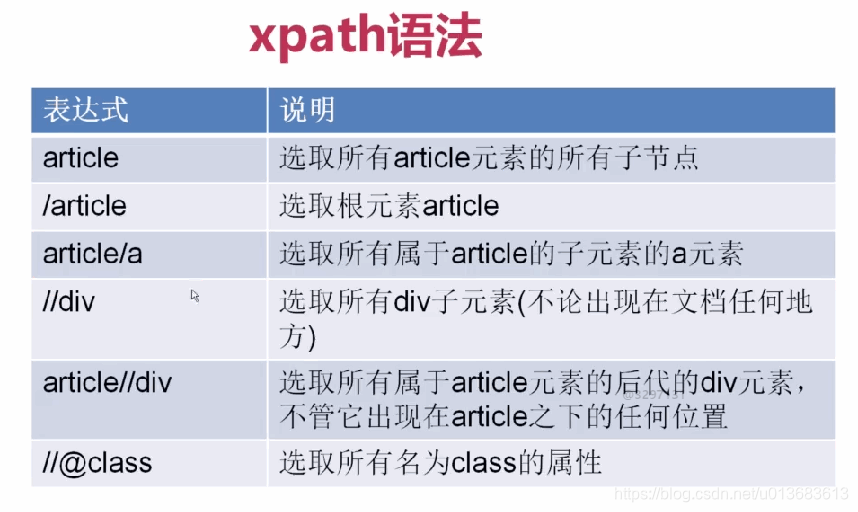第三百三十九节,Python分布式爬虫打造搜索引擎Scrapy精讲—Scrapy启动文件的配置—xpath表达式
我们自定义一个main.py来作为启动文件
main.py
#!/usr/bin/env python
# -*- coding:utf8 -*-
from scrapy.cmdline import execute #导入执行scrapy命令方法
import sys
import os
sys.path.append(os.path.join(os.getcwd())) #给Python解释器,添加模块新路径 ,将main.py文件所在目录添加到Python解释器
execute(['scrapy', 'crawl', 'pach', '--nolog']) #执行scrapy命令
爬虫文件
# -*- coding: utf-8 -*-
import scrapy
from scrapy.http import Request
import urllib.response
from lxml import etree
import re
class PachSpider(scrapy.Spider):
name = 'pach'
allowed_domains = ['blog.jobbole.com']
start_urls = ['http://blog.jobbole.com/all-posts/']
def parse(self, response):
pass
xpath表达式
1、

2、

3、

基本使用
allowed_domains设置爬虫起始域名
start_urls设置爬虫起始url地址
parse(response)默认爬虫回调函数,response返回的是爬虫获取到的html信息对象,里面封装了一些关于htnl信息的方法和属性
responsehtml信息对象下的方法和属性
response.url获取抓取的rul
response.body获取网页内容
response.body_as_unicode()获取网站内容unicode编码
xpath()方法,用xpath表达式过滤节点
extract()方法,获取过滤后的数据,返回列表
# -*- coding: utf-8 -*-
import scrapy
class PachSpider(scrapy.Spider):
name = 'pach'
allowed_domains = ['blog.jobbole.com']
start_urls = ['http://blog.jobbole.com/all-posts/']
def parse(self, response):
leir = response.xpath('//a[@class="archive-title"]/text()').extract() #获取指定标题
leir2 = response.xpath('//a[@class="archive-title"]/@href ').extract() #获取指定url
print(response.url) #获取抓取的rul
print(response.body) #获取网页内容
print(response.body_as_unicode()) #获取网站内容unicode编码
for i in leir:
print(i)
for i in leir2:
print(i)

